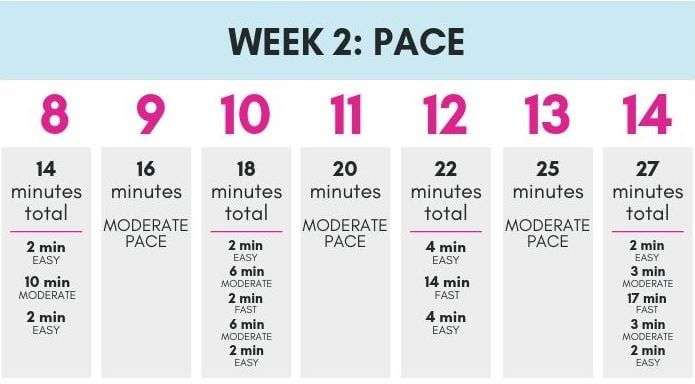If walking your way to weight loss never crossed your mind, think again! Walking for exercise is probably one of the most underrated forms of exercise when it comes to weight loss. Most people assume that in order to reach their weight loss goals they need to spend countless hours running or weight lifting. While these types of training styles are shown to increase fat loss and build lean muscle mass, they aren’t the only ways. In fact, anyone can benefit from a walking program to lose weight—it just requires a little bit of planning and understanding the proper progression needed in order to see your desired results.
This 21-day walking plan is a beginner walking program designed for anyone looking to lose weight by getting in their steps. By completing this program, you will improve your cardiovascular endurance, increase your metabolic rate, boost your energy levels, and ultimately, lose weight!
Here’s what we’ll cover…
- Health benefits of walking
- 5 tips to lose weight with walking
- 21-day walking plan [+downloadable guide]

Health Benefits Of Walking For Exercise
Walking is awesome. Honestly, it is. I mean, what’s not to love? It’s free, it’s simple, and it’s easy on your joints. Weight loss is just one of the many reasons to try a 21-day walking plan.
These are the health benefits you can expect when you start walking for exercise:
- Improved circulation
- Stronger joints and reduced muscular pain and stiffness
- Improved mood and mental clarity
- Improved sleep quality
- Increased cardiovascular and pulmonary fitness
- Reduced risk of heart disease, stroke, and heart disease
- Improved balance
- Reduced body fat

How To Lose Weight With Walking
Losing weight can be tricky considering the different factors at play. And much like any form of exercise, whether it’s weight lifting, jogging, or even playing sports, there are a few rules and non-negotiables you need to accept if you want to see lasting results. So, when you start a walking program to lose weight, incorporating these five strategies into your routine will help you ease into a healthier lifestyle overall and accelerate your results in the process.
1. Consistency is key
We’ve heard this phrase before, so why is it so important in regard to weight loss? Well, consistency leads to habits. Remember when you were a kid and your parents forced you to brush your teeth every morning and every night, despite the dramatic tantrums and objections? By being consistent with brushing your teeth at a young age, you were able to turn what was once a task you hated, into a habit that remains a part of your daily routine—and you do it without even thinking! It’s become something you do automatically. So, when you start walking for exercise, staying consistent will ensure that you are progressing the way you need to in order to see results.

2. Clean up your diet
I know, I know, I wish losing weight was easy enough to where this wasn’t a factor. But unfortunately, cleaning up your diet is a non-negotiable if you want to lose weight with walking. A poor diet is often times the primary factor that prevents people from reaching their health and fitness goals. Overeating is one of the most common reasons people gain weight because not only is it easy to lose track of how much you’re eating, but most foods are calorie-dense, which increases the likelihood that you’ll exceed your daily caloric intake. Reducing your total calories and eating real foods that are nutrient-dense will help reduce the likelihood of overeating. If you’re unsure how to get started with healthy eating, this clean eating grocery list will help you make smarter decisions next time you hit the grocery store.
3. Supplements are your friend
When you exercise regularly your metabolism starts operating more effectively. This means your body processes your calories and nutrients a lot quicker and more efficiently than it was when you weren’t exercising as much. It’s important to replenish your body with important nutrients that are lost during exercise—like electrolytes. Electrolytes regulate nerve and muscle function, keep the body hydrated, balance blood acidity and pressure, and help rebuild damaged tissue [1]. Similarly, consuming protein after a long walk will help your muscles recover quickly and even decrease soreness! Try this delicious Collagen Coconut Water for a quick fix of protein and electrolytes after a workout, or simply drink one scoop of SkinnyFit Repair & Recover with water. It’s packed with electrolytes and BCAAs to accelerate the healing process and give your muscles the nutrients they need to recover.

4. Recovery is crucial
In addition to good recovery supplements, doing a proper warm-up and cool-down before and after walking is essential to keeping up with your routine. I mean, really, is there anything worse than being so sore from a workout that you can’t even sit on the toilet without needing a forklift to help you get back up again? Who wants to exercise when they feel like that? No one. Which is why recovery is so important! Make sure to spend a good 5-10 minutes before and after your workout warming up and stretching to prevent injury and keep you limber!
5. Get your mind right
When it comes to weight loss, many people mistakenly approach it with the all-or-nothing mentality and go from 0-100 overnight. In theory, this might seem like a great idea but in reality, it can actually set you up to fail in the long term. One of the most common reasons people fail to see lasting results is from lack of planning and setting unrealistic goals from the get-go. So, before you jump into this 21-day walking plan, take a few minutes to learn how to set realistic weight loss goals. Doing so will give you a healthy advantage at the grocery store.

21-Day Walking Plan For Beginners
Walking is considered a type of low-intensity steady-state cardio, also known as LISS. This type of cardio is by far the most popular because it involves the repetition of the same movement for long periods of time—like running, cycling, or this beginner walking program, for example. It’s easy and doesn’t involve a ton of thinking. Studies show that 30-60 minutes of LISS training can help the body become conditioned over time to use fat as a fuel source. LISS is low-impact and helps with joint and bone health, improves your cardiovascular endurance, and prepares you for higher-intensity workouts.
By the end of this 21-day walking plan, you will increase your duration, pace, and resistance to improve your overall health and lose weight.
Here are a few key indicators to help you find an accurate pace based on where you are in the program. If you prefer to use heart rate training, use these heart rate zones based on your maximum heart rate.
- Easy—This should feel like a stroll. Your heart rate is in the Active Zone.
- Moderate—Your pace increases but you can still hold a conversation. Your heart rate is in the Training Zone.
- Fast—You are in a power walk and it will be difficult to hold a conversation. Your heart rate is in the Aerobic Zone.
Remember to warm up and cool down for 5 minutes before and after your walk!
Week 1
Your focus for week one is to slowly increase the duration of your walks. We’ll start small and work our way up to a healthy distance. Depending on your preference, you can either split the minutes and do a morning walk and evening walk, or you can complete the full time during one walk.

- Day 1—10 minutes, easy pace
- Day 2—12 minutes, easy pace
- Day 3—15 minutes, easy pace
- Day 4—18 minutes, easy pace (This might be a good time to split this time into morning and evening walks if you’re finding it difficult to complete the full time in one session—9 minutes in the morning and 9 minutes in the evening.)
- Day 5—20 minutes, easy pace (AM/PM split: 10 minutes in the morning and 10 minutes in the evening.)
- Day 6—22 minutes, easy pace (AM/PM split: 11 minutes in the morning and 11 minutes in the evening.)
- Day 7—25 minutes, easy pace (AM/PM split: 13 minutes in the morning and 12 minutes in the evening.)
Week 2
The primary focus this week will be increasing your pace! We’ll practice short circuits from easy to moderate-paced walking.

- Day 8—14 minutes (2 minutes easy, 10 minutes moderate, 2 minutes easy)
- Day 9—16 minutes, moderate pace
- Day 10—18 minutes (2 minutes easy, 6 minutes moderate, 2 minutes fast, 6 minutes moderate, 2 minutes easy)
- Day 11—20 minutes, moderate pace
- Day 12—22 minutes (4 minutes easy, 14 minutes fast, 4 easy)
- Day 13—25 minutes, moderate pace
- Day 14—27 minutes (2 minutes easy, 3 minutes moderate, 17 minutes fast, 3 minutes moderate, 2 minutes easy)
Week 3
Week 3 will be all about increasing your resistance. This can be walking uphill, hiking, or even taking the stairs. Your pace will fluctuate from easy to moderate, however, adding resistance will increase your heart rate to the high-end of the aerobic zone.

- Day 15—15 minutes walking uphill with increasing elevation or up stairs
- Day 16—25 minutes, moderate pace
- Day 17—20 minutes (17 minutes walking uphill with increasing elevation or up stairs at an easy pace, 3 minutes easy pace on flat level)
- Day 18—23 minutes, moderate pace
- Day 19—27 minutes (20 minutes walking uphill with increasing elevation or up stairs at an easy pace, 7 minutes easy on flat level)
- Day 20—30 minutes, moderate pace
- Day 21—33 minutes (25 minutes fast-paced walking, 8 minutes easy walking)
